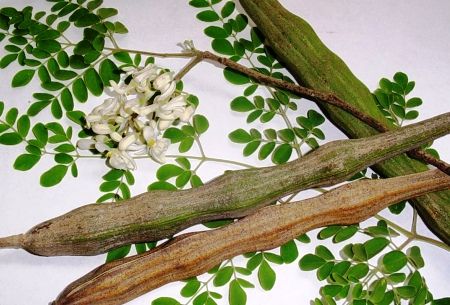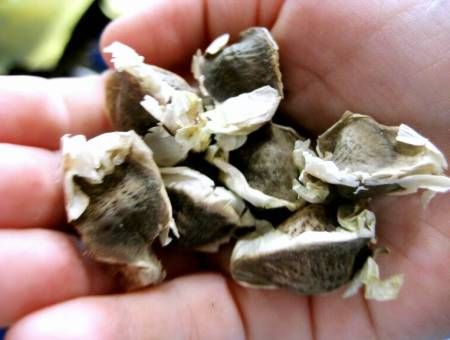
Moringa Water Treatment
In addition to food, shelter and clothing, water is one of our basic human needs and lack of potable water is a major cause of death and disease in our world. The purpose of this document is to provide information on household water treatment using seeds of the Moringa oleifera tree.
Using natural materials to clarify water is a technique that has been practiced for centuries and of all the materials that have been used, seeds of the Moringa have been found to be one of the most effective. Studies have been conducted since the early 1970's to test the effectiveness of Moringa seeds for treating water. These studies have confirmed that the seeds are highly effective in removing suspended particles from water with medium to high levels of turbidity (Moringa seeds are less effective at treating water with low levels of turbidity).
Theory
Moringa oleifera seeds treat water on two levels, acting both as a coagulant and an antimicrobial agent. It is generally accepted that Moringa works as a coagulant due to positively charged, water-soluble proteins, which bind with negatively charged particles (silt, clay, bacteria, toxins, etc) allowing the resulting “flocs” to settle to the bottom or be removed by filtration. The antimicrobial aspects of Moringa continue to be researched. Findings support recombinant proteins both removing microorganisms by coagulation as well as acting directly as growth inhibitors of the microorganisms. While there is ongoing research being conducted on the nature and characteristics of these components, it is accepted that treatments with Moringa solutions will remove 90-99.9% of the impurities in water.

Water Treatment with Moringa Seeds
Solutions of Moringa seeds for water treatment may be prepared from seed kernels or from the solid residue left over after oil extraction (presscake). Moringa seeds, seed kernels or dried presscake can be stored for long periods but Moringa solutions for treating water should be prepared fresh each time. In general, 1 seed kernel will treat 1 liter (1.056 qt) of water.
Dosage Rates:
Solutions of Moringa seeds for water treatment may be prepared from seed kernels or from the solid residue left over after oil extraction (presscake). Moringa seeds, seed kernels or dried presscake can be stored for long periods but Moringa solutions for treating water should be prepared fresh each time. In general, 1 seed kernel will treat 1 liter (1.056 qt) of water.
Dosage Rates:
- Low turbidity NTU < 50 1 seed per 4 liters (4.225 qt) water
- Medium turbidity NTU 50 - 150 1 seed per 2 liters (2.112 qt) water
- High turbidity NTU 150 - 250 1 seed per 1 liter (1.056 qt) water
- Extreme turbidity NTU > 250 2 seeds per 1 liter (1.056 qt) water
Instructions to Clean Water with Moringa Seeds
- Collect mature Moringa oleifera seed pods and remove seeds from pods.
- Shell seeds (remove seed coat) to obtain clean seed kernels; discard discolored seeds.
- Determine quantity of kernels needed based on amount and turbidity of water; in general 1 seed kernel will treat 1 liter (1.056 qt) of water.
- Crush appropriate number of seed kernels (using grinder, mortar and pestle, etc) to obtain a fine powder and sift the powder through a screen or small mesh.
- Mix seed powder with a small amount of clean water to form a paste.
- Mix the paste and 250 ml (1 cup) of clean water into a bottle and shake for 1 minute to activate the coagulant properties and form a solution.
- Filter this solution through a muslin cloth or fine mesh screen (to remove insoluble materials) and into the water to be treated.
- Stir treated water rapidly for at least 1 minute then slowly (15-20 rotations per minute) for 5-10 minutes.
- Let the treated water sit without disturbing for at least 1-2 hours.
- When the particles and contaminates have settled to the bottom, the clean water can be carefully poured off.
- Mix seed powder with a small amount of clean water to form a paste.
- Mix the paste and 250 ml (1 cup) of clean water into a bottle and shake for 1 minute to activate the coagulant properties and form a solution.
- Filter this solution through a muslin cloth or fine mesh screen (to remove insoluble materials) and into the water to be treated.
- Stir treated water rapidly for at least 1 minute then slowly (15-20 rotations per minute) for 5-10 minutes.
- Let the treated water sit without disturbing for at least 1-2 hours.
- When the particles and contaminates have settled to the bottom, the clean water can be carefully poured off.
- This clean water can then be filtered or sterilized to make it completely safe for drinking.
DANGERS
Secondary Infection: The process of shaking and stirring must be followed closely to activate the coagulant properties; if the flocculation process takes too long, there is a risk of secondary bacteria growth during flocculation.
- Recontamination: The process of settling is important. The sediment at the bottom contains the impurities so care must be taken to use only the clear water off the top and not allow the sediment to re-contaminate the cleared water.
- Additional contaminants: Moringa treatment does not remove 100% of water pathogens.
- It is acceptable for drinking only where people are currently drinking untreated, contaminated water.
By Beth Doerr, ECHO Staff













































No comments:
Post a Comment